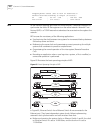
NTP 279
■ Ethernet Switch B serves as an NTP time server and Ethernet Switch A
synchronizes the local clock with the clock of B.
■ It takes 1 second to transmit a data packet from either A or B to the opposite
end.
The system clocks are synchronized as follows:
■ Ethernet Switch A sends an NTP packet to Ethernet Switch B. The packet
carries the timestamp 10:00:00am (T1) that tells when it left Ethernet Switch A.
■ When the NTP packet arrives at Ethernet Switch B, Ethernet Switch B adds a
local timestamp 11:00:01am (T2) to it.
■ When the NTP packet leaves Ethernet Switch B, Ethernet Switch B adds
another local timestamp 11:00:02am (T3) to it.
■ When Ethernet Switch A receives the acknowledgement packet, it adds a new
timestamp 10:00:03am (T4) to it.
Next, Ethernet Switch A collects enough information to calculate the following
two important parameters:
■ The delay for a round trip of an NTP packet traveling between the Switch A and
B: Delay= (T4-T1) - (T3-T2).
■ Offset of Ethernet Switch A clock relative to Ethernet Switch B clock: offset= (
(T2-T1) + (T3-T4) ) /2.
Ethernet Switch A uses this information to set the local clock and to synchronize it
with the clock on Ethernet Switch B.
Configuring NTP is described in the following sections:
■ Configuring NTP
■ NTP Configuration Examples
Configuring NTP NTP configuration includes the tasks described in the following sections:
■ Configuring NTP Operating Mode
■ Configuring NTP ID Authentication
■ Setting the NTP Authentication Key
■ Setting the Specified Key to Be Reliable
■ Designating an Interface to Transmit the NTP Message
■ Setting the NTP Master Clock
■ Enabling or Disabling an Interface to Receive an NTP Message
■ Setting the Authority to Access a Local Switch
■ Setting Maximum Local Sessions
■ Displaying and Debugging NTP
Configuring NTP Operating Mode
The Switch 7750 can serve as an NTP client but not as an NTP server.


















